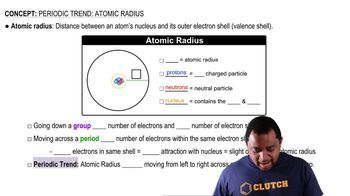Here are the essential concepts you must grasp in order to answer the question correctly.
Atomic Radius
Atomic radius refers to the size of an atom, typically measured from the nucleus to the outermost electron shell. As you move across a period in the periodic table, the atomic radius generally decreases due to the increasing positive charge of the nucleus, which pulls the electrons closer, resulting in a smaller atomic size.
Recommended video:
Effective Nuclear Charge (Z_eff)
Effective nuclear charge is the net positive charge experienced by an electron in a multi-electron atom. As you move across a period, the number of protons increases while the shielding effect from inner electrons remains relatively constant, leading to a higher Z_eff. This increased attraction between the nucleus and the valence electrons causes the atomic radius to decrease.
Recommended video:
Transition Elements and Electron Shielding
Transition elements exhibit unique electron configurations that involve d-orbitals. As you move across the transition metals, the addition of electrons to the d-orbitals does not significantly increase the effective nuclear charge felt by the outermost s-electrons due to increased electron shielding. This results in a less pronounced decrease in atomic radius compared to main-group elements.
Recommended video:
Transition Metals Valence Electrons
 Verified step by step guidance
Verified step by step guidance

